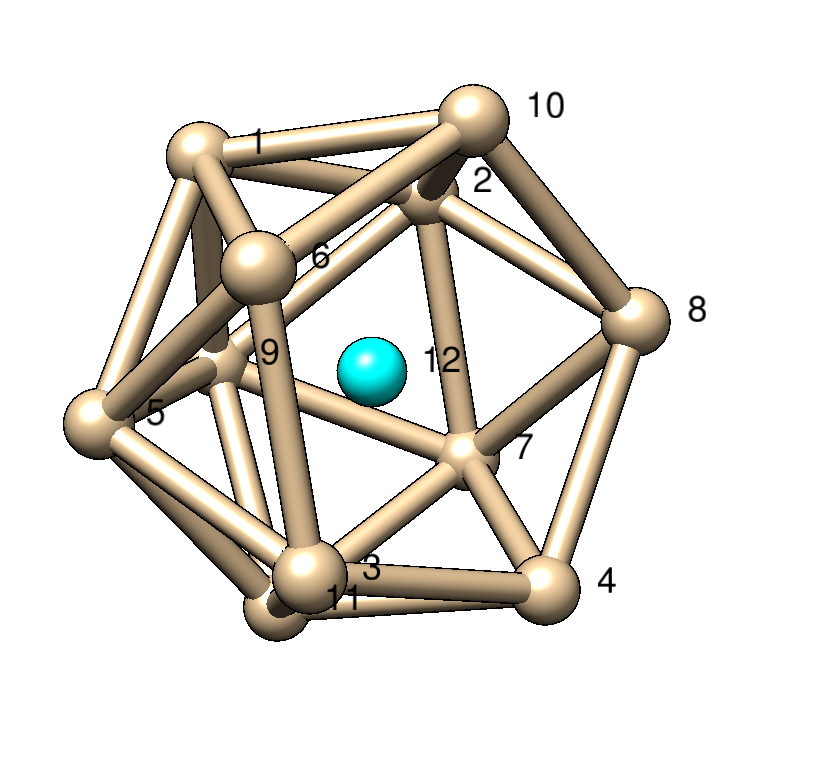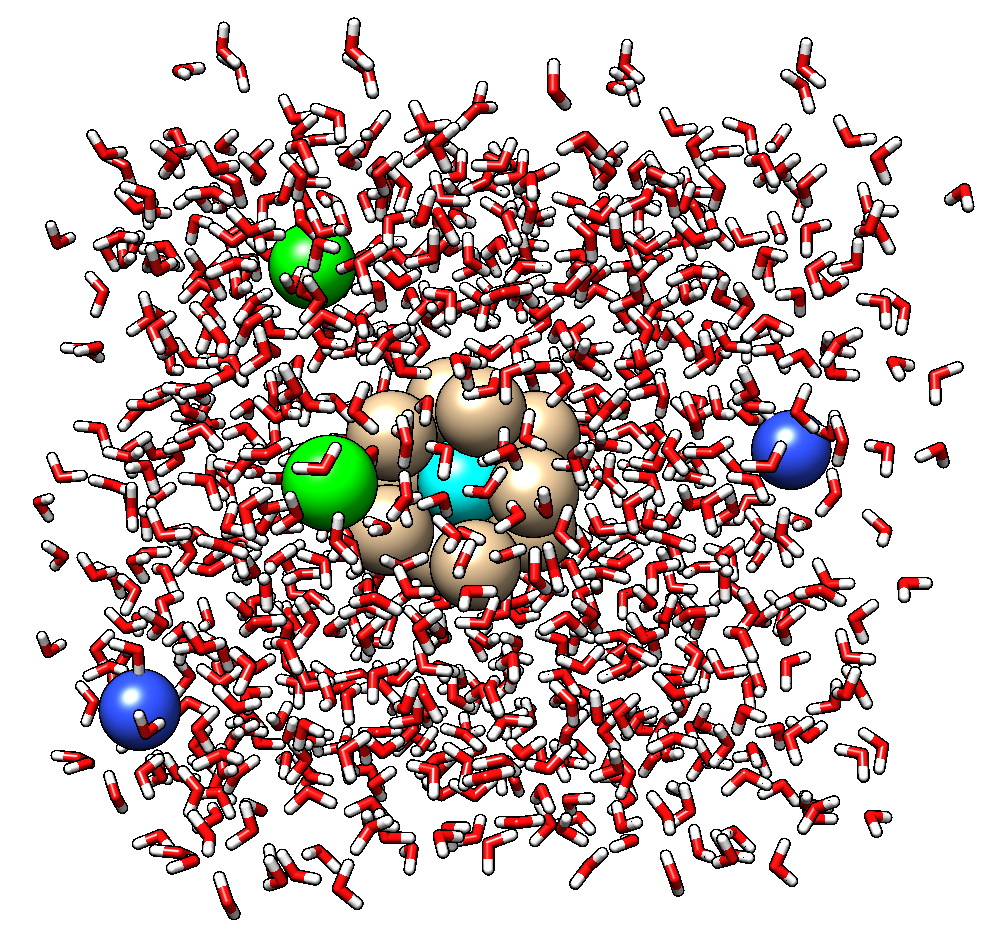A GitHub repository for the toy_binding project.
For MSM estimation, we are using the msmtools library from The Noé group. You can install this librrary through conda using:
conda install -c https://conda.binstar.org/omnia msmtools
In this work, we simulate a "toy" binding system in which a ligand can bind and unbind to toy binding pocket. Using this system as a benchmark, our goal is to evaluate the effectiveness of various enhanced sampling schemes to estimate binding affinity and kinetics.
The ligand is a single, uncharged Lennard-Jones (LJ) particle with the same parameters as a CT carbon atom in the AMBER force fields.
The binding pocket to an 11-particle icosahedral binding pocket made from the same atom type.
From `pocket.top':
;
; Topology file the pocket
;
; The force-field files to be included
#include "amber99sbnmr1-ildn.ff/forcefield.itp"
;[ defaults ]
; nbfunc comb-rule gen-pairs fudgeLJ fudgeQQ
;1 2 yes 0.5 0.8333
[ atomtypes ]
; name at.num mass charge ptype sigma epsilon
LJ 6 12.01 0.0000 A 3.39967e-01 4.57730e-01 ; copied from amber LJ
[ bondtypes ]
; i j func b0 kb
LJ LJ 1 0.40124 259408.0 ; 7,(1986),230; AA, SUGARS
[ angletypes ]
; i j k func th0 cth
LJ LJ LJ 1 108.000 150.0 ; wide icosahedron angle IMPORTANT!
[ dihedraltypes ]
;i j k l func
LJ LJ LJ LJ 9 0.0 0.75312 3 ; Junmei et al, 1999
LJ LJ LJ LJ 9 180.0 1.04600 2 ; Junmei et al, 1999
LJ LJ LJ LJ 9 180.0 0.83680 1 ; Junmei et al, 1999
[ moleculetype ]
; name nrexcl
Pocket 3
[ atoms ]
1 LJ 1 DUM C1 1 0.000000 12.01000 ; amber C type
2 LJ 1 DUM C2 2 0.000000 12.01000 ; amber C type
3 LJ 1 DUM C3 3 0.000000 12.01000 ; amber C type
4 LJ 1 DUM C4 4 0.000000 12.01000 ; amber C type
5 LJ 1 DUM C5 5 0.000000 12.01000 ; amber C type
6 LJ 1 DUM C6 6 0.000000 12.01000 ; amber C type
7 LJ 1 DUM C7 7 0.000000 12.01000 ; amber C type
8 LJ 1 DUM C8 8 0.000000 12.01000 ; amber C type
9 LJ 1 DUM C9 9 0.000000 12.01000 ; amber C type
10 LJ 1 DUM C10 10 0.000000 12.01000 ; amber C type
11 LJ 1 DUM C11 11 0.000000 12.01000 ; amber C type
12 LJ 1 DUM C12 12 0.000000 12.01000 ; amber C type
[ bonds ]
; ai aj funct
1 2 1
1 5 1
1 6 1
1 9 1
1 10 1
2 7 1
2 8 1
2 9 1
2 10 1
3 4 1
3 5 1
3 6 1
3 11 1
4 7 1
4 8 1
4 11 1
5 6 1
5 9 1
5 11 1
6 10 1
7 8 1
7 9 1
7 11 1
8 10 1
9 11 1
[ angles ]
; ai aj ak funct
1 2 7 1
1 2 8 1
1 5 11 1
1 9 11 1
2 7 11 1
2 9 11 1
3 4 7 1
3 4 8 1
3 5 9 1
3 6 10 1
4 7 9 1
4 8 10 1
5 6 10 1
7 8 10 1
; Include water topology
#include "amber99sbnmr1-ildn.ff/tip3p.itp"
; Include ion topology
#include "amber99sbnmr1-ildn.ff/ions.itp"
[ system ]
Pocket in Water
[ molecules ]
;molecule name nr.
Pocket 1
The then solvated in a cubic periodic box of 860 TIP3P waters, two Na+ ions, two Cl- ions, pressure equilibrated using NPT (see setup), then run at NVT using a (3.00859 nm)^3 cubic periodic box.
Our first task with this system was to find a value of the Lennard-Jones parameter ε that will work well as a challenging test of binding affinities and rates. We sought to find parameters such that the slowest binidng/unbinding times are on the timescale of hundreds of nanoseconds.
We kept the original σ parameter (for carbon) the same (0.339967 nm), and varied the ε value from 0.0 to 10.0 kJ/mol in increments of 0.5 kJ/mol (the original value was 0.457730 kJ/mol). For each value of epsilon, we simulated 10 trajectories of length 1 µs, resulting in a total of 210 µs of aggregate trajecory data. Snapshots were recorded every 100 ps. This data is found in free_simulation/all_epsilon.
Naive estimates of the free energy of binding and rates were made directy from the trajectory data, assuming the simulations sample from the equilibirum distribution. The analsys showed increased bound-state stability and slower kinetics as a function of epsilon.
[ show graph here ]
From these rough estimates, we chose an epsilon value of 2.5 kJ/mol for all subsequent tests, for which the ∆G of binding is about XXXX kJ/mol, and the kobs = k_b + k_u (estimated from a simple few-state MSM) was about XXXXX ns.
Next, we were interested in how best to use harmonic biases and FEP to estimate binding affinity and kinetics.
The Noé group has shown that uncertainty of thermodynamic estimates is larger with MBAR than with a multi-ensemble MSM estimator like dTRAM or TRAM. We can show this for our model system as well. Specifically, we need a graph showing that as more trajectory data is included, binding free energy uncertainty estimates decrease faster using dTRAM/TRAM than with MBAR.
Similarly, we hope to show that uncertainties in estimated rates decrease faster with dTRAM/TRAM than with a standard MSM estimator.
We compare

